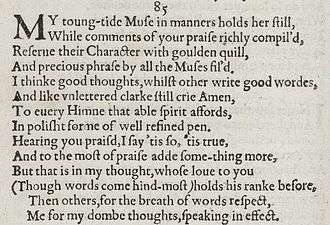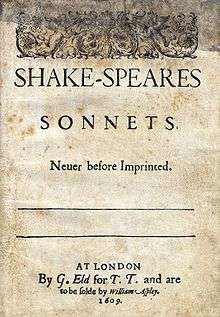Sonnet 85
Sonnet 85 is one of 154 sonnets published by the English playwright and poet William Shakespeare in 1609. It's part of the Fair Youth sequence, and the eighth sonnet of the Rival Poet group.
| Sonnet 85 | |||||||
|---|---|---|---|---|---|---|---|
 Sonnet 85 in the 1609 Quarto | |||||||
| |||||||
Exegesis
This sonnet and the previous one (Sonnet 84) expand on the idea of the poet's silence. The poet is tongue-tied observer, but recognizes the beautiful praises being expressed by a rival poet. The poet asserts that his own tacit, though inwardly felt devotion is worth even more. It is, paradoxically, a complexly eloquent sonnet supporting the superiority of unspoken love. The Muse (line 1) is holding her silence, and respectfully allowing the rival to speak. Or line 1 may be suggesting that the rival poet's flattery is rude, and it is a sense of manners that continues ("still") to maintain the poet in silence. The young man's character is being preserved (line 3) with beautiful fancy writing ("golden quill"). It was the job of the parish clerk to lead the congregation in saying aloud "amen"; an illiterate clerk might say "amen" too often (line 6). The poet's love maintains a place ahead of the others ("holds his rank before"). The couplet contextualizes the "breath" mentioned in Sonnet 81, and derogates words ("others for the breath of words respect") for being insubstantial as a breath, and favors the poets own silent thoughts. The effect the young man is having on the poets is placed in two extremes: The poets are either spinning out glorious words and phrases, or they are struck dumb. Both extremes are contained in the paradox of this elaborately worded sonnet that speaks in favor of silence.[2][3][4]
Structure
Sonnet 85 is an English or Shakespearean sonnet, which has three quatrains, followed by a final rhyming couplet. It follows the rhyme scheme ABAB CDCD EFEF GG and is composed in iambic pentameter, a metre of five feet per line, with two syllables in each foot accented weak/strong. Most of the lines are examples of regular iambic pentameter, including the 1st line:
× / × / × / × / × / My tongue-tied Muse in manners holds her still This is followed in line 2) by a reversal of the accents in the word "richly": × / × / × / / × × / While comments of your praise richly compiled (85.1-2)
- / = ictus, a metrically strong syllabic position. × = nonictus.
A reversal in the first foot occurs in line 9.
The meter calls for a few variant pronunciations: line 7's "spirit" can be pronounced as 1 syllable,[5] and line 8's "refinèd" as 3.[6]
Notes
- Shakespeare, William. Duncan-Jones, Katherine. Shakespeare’s Sonnets. Bloomsbury Arden 2010. p. 281 ISBN 9781408017975.
- Shakespeare, William. Duncan-Jones, Katherine. Shakespeare’s Sonnets. Bloomsbury Arden 2010. p. 280 ISBN 9781408017975.
- Booth, Stephen, ed. Shakespeare's Sonnets (Rev. ed.). New Haven: Yale Nota Bene. (2000) p. 283
- Hammond, Gerald. The Reader and the Young Man Sonnets. Barnes & Noble. 1981. p. 107. ISBN 978-1-349-05443-5
- Booth 2000, p. 262 & 287.
- Booth 2000, p. 75.
References
- First edition and facsimile
- Shakespeare, William (1609). Shake-speares Sonnets: Never Before Imprinted. London: Thomas Thorpe.CS1 maint: ref=harv (link)
- Lee, Sidney, ed. (1905). Shakespeares Sonnets: Being a reproduction in facsimile of the first edition. Oxford: Clarendon Press. OCLC 458829162.
- Variorum editions
- Alden, Raymond Macdonald, ed. (1916). The Sonnets of Shakespeare. Boston: Houghton Mifflin Company. OCLC 234756.
- Rollins, Hyder Edward, ed. (1944). A New Variorum Edition of Shakespeare: The Sonnets [2 Volumes]. Philadelphia: J. B. Lippincott & Co. OCLC 6028485.
- Modern critical editions
- Atkins, Carl D., ed. (2007). Shakespeare's Sonnets: With Three Hundred Years of Commentary. Madison: Fairleigh Dickinson University Press. ISBN 978-0-8386-4163-7. OCLC 86090499.
- Booth, Stephen, ed. (2000) [1st ed. 1977]. Shakespeare's Sonnets (Rev. ed.). New Haven: Yale Nota Bene. ISBN 0-300-01959-9. OCLC 2968040.
- Burrow, Colin, ed. (2002). The Complete Sonnets and Poems. The Oxford Shakespeare. Oxford: Oxford University Press. ISBN 978-0192819338. OCLC 48532938.
- Duncan-Jones, Katherine, ed. (2010) [1st ed. 1997]. Shakespeare's Sonnets. The Arden Shakespeare, Third Series (Rev. ed.). London: Bloomsbury. ISBN 978-1-4080-1797-5. OCLC 755065951.
- Evans, G. Blakemore, ed. (1996). The Sonnets. The New Cambridge Shakespeare. Cambridge: Cambridge University Press. ISBN 978-0521294034. OCLC 32272082.
- Kerrigan, John, ed. (1995) [1st ed. 1986]. The Sonnets ; and, A Lover's Complaint. New Penguin Shakespeare (Rev. ed.). Penguin Books. ISBN 0-14-070732-8. OCLC 15018446.
- Mowat, Barbara A.; Werstine, Paul, eds. (2006). Shakespeare's Sonnets & Poems. Folger Shakespeare Library. New York: Washington Square Press. ISBN 978-0743273282. OCLC 64594469.
- Orgel, Stephen, ed. (2001). The Sonnets. The Pelican Shakespeare (Rev. ed.). New York: Penguin Books. ISBN 978-0140714531. OCLC 46683809.
- Vendler, Helen, ed. (1997). The Art of Shakespeare's Sonnets. Cambridge, MA: The Belknap Press of Harvard University Press. ISBN 0-674-63712-7. OCLC 36806589.
.png)
